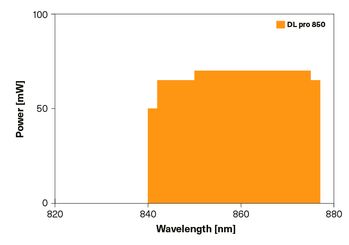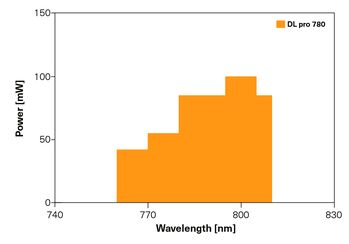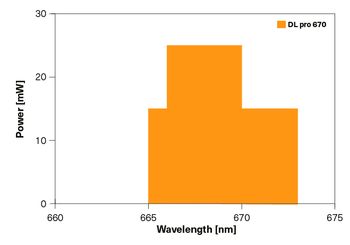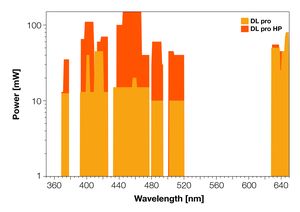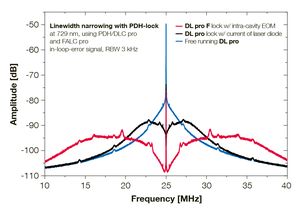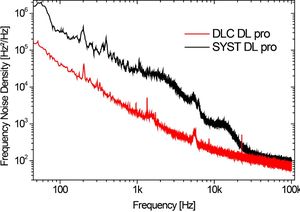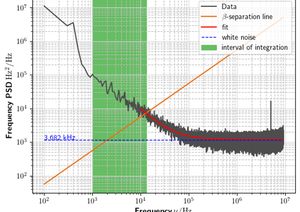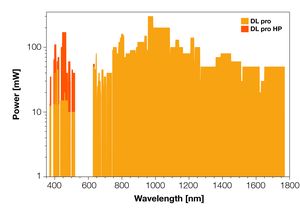 DL pro (HP): Available wavelengths and corresponding output power levels
DL pro (HP): Available wavelengths and corresponding output power levels


DL pro
Tunable diode laser available with digital control DLC pro
- Tunable diode laser in patented pro design
- Ultra-stable against temperatures & acoustics
- With digital control DLC pro: Superior performance and remote control
- Linewidth down to 0.6 kHz free running
- Linewidth below 1 Hz possible with lock to external reference cavity
Our DL pro is the ultimate tunable diode laser. Its revolutionary mechanical design allows for both easy operation and extreme stability at the same time. It offers highest output powers, and optimized mode-hop-free tuning with a perfectly positioned virtual pivot point for the grating movement (Patents: DE 10 2007 028 499 and US 7970024). Together with the digital control DLC pro controller it shows unrivalled linewidth and drift – with the most comfortable and intuitive user interface. A software license may be purchased to enable frequency-locking features.
The DL pro HP diode laser features a special resonator design, which allows for higher single-mode output powers from "visible" laser diodes. Like the DL pro, it is an extended cavity diode laser (ECDL). Both lasers feature various modulation inputs and may be equipped with various options like fiber coupling, beam shaping etc.
With the DL pro F locking is faster than ever, laying the foundation for the next generation quantum technology. The F variant of our DL pro features an intra-cavity EOM which provides two feedback channels. One is used for fast adjustments to ensure the superb locking performance, the other guarantees the high robustness of the lock.
We provide a wide range of Top Sellers which are turnkey solutions for typical applications such as laser cooling of atoms or ions. These systems combine a DLC pro and either a DL pro, DL pro HP or DL pro F including an appropriate isolator. They may be combined with fiber coupling and the software license enabling frequency-locking features.
Top Sellers are available at these wavelengths:
369, 397, 399, 420, 461, 633, 637, 670, 674, 729, 780 and 850 nm.
See Additional Top Seller section below for details.
Furthermore, the DL pro is available with all laser diodes listed in our stocklist of AR-coated and Fabry-Perot laser diodes. An overview of the resulting wavelength coverage is shown in the Additional Information section below.
The DL pro BFY provides the most recent generation of ECDL. The hermetically sealed butterfly package and the compact design of the resonator allow for a superior passive mode-stability and robustness compared with others ECDL‘s. It is especially suitable for applications where a care-free operation of the lasers is required.
-
Specification
DLC DL pro DLC DL pro HP DLC DL pro F DLC DL pro BFY Wavelength coverage 369 .. 519 nm *, 628 .. 1770 nm * 369 .. 519 nm *, 633 .. 641 nm please inquire 670 .. 900 nm *, for other wavelegnths please inquire Typical power range 10 .. 300 mW 15 .. 400 mW after the isolator similar to DLC DL pro 33 .. 65 mW after the isolator Typical coarse tuning range 2 .. 100 nm 2 .. 5 nm ±0.1 nm Typical mode-hop free tuning range ≥ 20 GHz ≥ 5 GHz Typical instantaneous linewidth 0.6 .. 90 kHz 10 .. 850 kHz 1 .. 30 kHz **** 10 kHz -
Additional Top Seller
DLC DL pro ... HP
369HP
397HP
399HP
420HP
461
633Typical applications Yb ion cooling Ca ion cooling Yb cooling Ca cooling, Sr ion cooling, Rb Rydberg Sr cooling, Cs Rydberg,
K RydbergHeNe laser wave-
lengthPeak power (mW) after the isolator, specified (typical) 13 65 110 70 400 40 Wavelength (nm) 368.5 - 370.8 396.5 - 398.5 399 - 400.5 420 - 423 457 - 461 631 - 635 Typical instantaneous linewidth (kHz) 850 340 340a 340a 40 200 (5 µs)b Included optical isolator > 28 dB > 35 dB > 35 dB > 35 dB > 35 dB > 60 dB Polarisation linear, PER 100:1 Polarisation axis diagonal vertical Fiber coupling efficiency with FiberDock (optional), specified (typical) 55% (65%) replacement of laser diode in factory by customer Ships from stock no no no no no no More power with DLC TA pro or BoosTA available no no no no no no (Even) more power with DLC TA-SHG pro available yes yes yes yes yes yes -
Additional Information
-
Options
Narrow linewidth

With this option DL pro laser systems are optimized for narrow linewidths. It is also suited for seed lasers of TA or NLO systems as well as lasers of Laser Rack Systems but not for DL pro HP lasers. DL pro F lasers are always optimized for a narrow linewidth. Fiber Delivery

Fiber Delivery (FD) is optionally available with TOPTICA's patented fiber coupler FiberDock and a suitable polarization maintaining (PM) fiber. FiberDock provides highest single-mode fiber coupling efficiencies, easy alignment and at the same time highest stability.
For most lasers, we specify a PER behind fiber of >20 dB with our Fiber Delivery option. Please also inquire about Long Life and High Power fibers as well as fiber splitters. Optical isolation is mandatory for fiber coupled diode laser systems.Optical Isolation


Isolators are used to protect the laser diode against back reflections. This not only prevents damage to the diode but also ensures untroubled tuning and single-frequency operation. Fiber-coupling with angle-polished fibers (both ends) requires at least a single-stage isolator (> 30 dB). Double-stage isolators are needed if reflections from the experiment into the laser are expected. Fiber-coupling with non-angle-polished fibers also requires a double-stage isolator (> 60 dB). Beam Shaping

To shape elliptical laser beams into round profiles, either an anamorphic prism pair (APP) or cylindrical lenses are used. The compression ratio is set at the factory. Motorization

The motorization of the coarse tuning offers manual control and operation via software interface. This option is available for most DL pro laser systems (most AR laser diodes and some FP diodes) including DL pro HP laser systems but not for DL pro F systems. See Downloads section below. Bias-T

The DL pro (HP) has two modulation inputs that allow current modulation frequencies of up to 150 MHz. A Bias-T allows even higher current modulation frequencies of up to several GHz, depending on the diode. It is also suited for seed lasers of TA or NLO systems. This option is not available for DL pro F systems. Electronics Modules A broad variety of electronic locking modules is available for frequency stabilization. -
Applications
- Atom Laser Cooling & Trapping
- Ion Laser Cooling & Trapping
- BEC
- Degenerate Fermi Gases
- Optical Clocks
- Rydberg Excitation (Rydberg Flyer for complete laser solutions)
- Optical Pumping & EIT
- Fundamental Constants
- Interferometry
- Quantum Cryptography
- Quantum Information
- Quantum Dots & Microcavities
- Magnetic Field Measurement
-
Downloads
Software
- For software updates and Python support of the digital laser controller please see the Downloads section on the DLC pro page.
Technical information
- Product Brochure: Tunable Diode Lasers (please see website for latest specs!)
- Short Info: DL pro
- Technical Drawings: DL pro (standard laser head)
This laser head is used for all TopSellers and all DL pro HP as well as most configured DL pro. - Technical Drawings: DL pro (long laser head)
This longer housing is used if additional space is needed to fit the optical components into the laser head.
- For software updates and Python support of the digital laser controller please see the Downloads section on the DLC pro page.
-
Literature
Application notes and publications
- Article: Lang, M. et al., Digital Revolution in Laser Control, Physics' Best (2014)
- Article: Lang, M. et al., Rauscharme Revolution, Best of (2013)
- Article: Lang, M. et al., Digitale Bedienkonzepte halten Einzug ins Laserlabor, LASER (2014)
- Application Note: Biomagnetic measurements benefit from laser know-how
- Application Note: Temperature measurements above the Arctic
- Application Note: Trapping and quantum computing
- Scientific Publications: B. Sprenger et al., CaF2 whispering-gallery-mode-resonator stabilized-narrow-linewidth laser; Opt. Lett. 35, 17 (2010)
- Scientific Article (using DL pro stabilized to < 1 Hz linewidth): T. Puppe et al., Characterization of a DFG comb showing quadratic scaling of the phase noise with frequency, Optics Letters Vol. 41, Issue 8 (2016)
- Application Note: Phase and Frequency Locking of Diode Lasers
- Application Note: Linewidth Measurement of Diode Lasers
Current scientific publications mentioning TOPTICA DL pro
-
Related Products
- MDL pro: Rack integration of DL pro, also as part of T-RACK
- DLC pro: All-digital driver electronics
- CTL: Continuously tunable diode laser
- DFB pro: Laser with DFB or DBR diodes
- TA pro: pro series ECDL with tapered amplifier
- BoosTA pro: Semiconductor amplifier for higher powers
- Frequency converted diode lasers: Extending the wavelength coverage of ECDLs
- Fiber Dock and Optical Fibers: Delivering the light of the DL pro or cleaning its spatial mode
- Laser Locking Electronics: A broad variety is available for frequency stabilization
- Numerous Photonicals, tools and helpful equipment for working with lasers, for example Fabry-Perot Interferometers or Compact Saturation Spectroscopy setups CoSy
- AR-coated Laser Diodes and Fabry-Perot Laser Diodes: See stock list for specifications of available laser power, tuning ranges and laser linewidths of these diodes if operated in a DL pro.

